14 Unhealthiest Pancake Toppings You Should Avoid
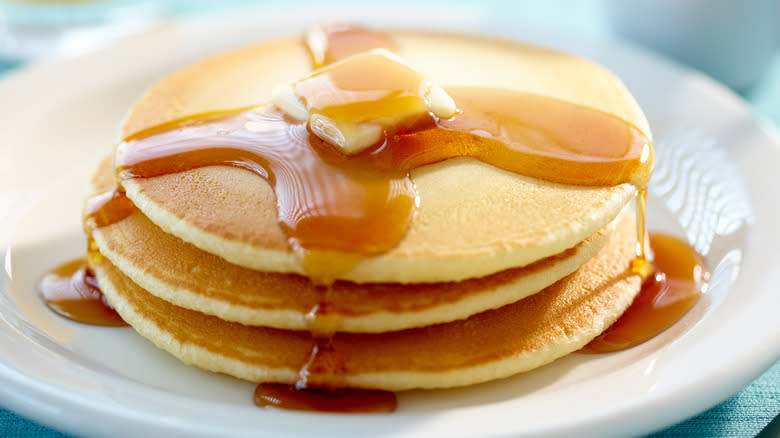
There's no better way to start the day than with cake for breakfast. But we're not talking about the frosting-covered stuff you eat on birthdays. We mean pancakes, the type of dessert you can enjoy first thing in the morning and no one will bat an eye. Though it depends on the recipe or box mix, pancakes tend to contain a lot of sugar (which is why they're so tasty). No batch of pancakes is complete without the toppings, but these additions can bring a lot of fat, salt, and even more sugar to the plate.
To help you navigate these waters, we compiled a list of the least healthy toppings you can add to your pancakes. These foods are high in sugar, sodium, or fat and often contain artificial flavors, preservatives, and other unwanted additives. We explain more about how we chose our pancake toppings at the end of the list.
Of course, it's still possible to enjoy any of your favorite toppings. After all, everyone has different dietary needs and can make their own choices. We admit that we still indulge in some of them from time to time (the classic maple syrup and butter combo is our favorite). What's more, for many of these toppings, there are ways to make them at least slightly healthier, and this we'll explain below.
Read more: 15 Mistakes Everyone Makes When Cooking Eggs
1. Butter
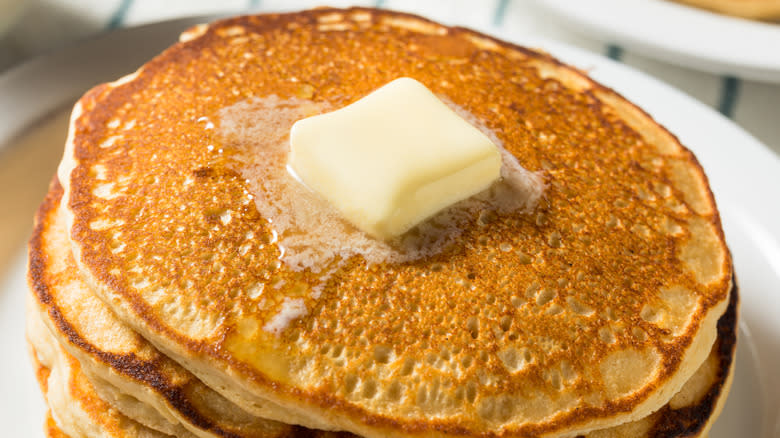
Butter makes everything better, and this is certainly true for pancakes. While pancakes already typically contain butter in the batter, many people enjoy adding a little extra on top. But as you may suspect, butter is high in calories. For example, 1 tablespoon of Lucerne salted butter, the size of one serving, provides 100 calories. Given its high caloric content, eating large amounts of butter can lead to weight gain. While everyone's healthy weight range is different, too much extra weight can increase the risk of heart disease and diabetes.
Butter is also high in saturated fat. If we return to our Lucerne salted butter, one serving contains 35% of the day's recommended amount of saturated fat. While saturated fat has long had a bad reputation, recent studies have not been able to connect the consumption of saturated fat with a greater risk of developing heart disease. However, the Dietary Guidelines for Americans still recommends limiting saturated fat intake to 10% or less of calories consumed in any given day. In other words, butter is fine in moderation.
2. Whipped Cream
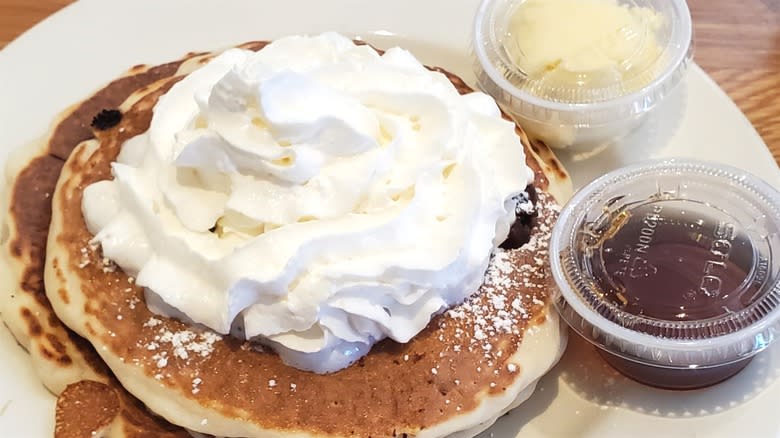
Whether for breakfast or dessert (or both), whipped cream is always a hit. True whipped cream typically consists of heavy whipping cream or heavy cream, vanilla extract, and sugar. A 2-tablespoon serving of the sweet, fluffy cream carries 100 calories and 10 grams of fat. We don't know about you, but 2 tablespoons is rarely enough. With each extra spoonful, the calorie and fat content increases.
For convenience's sake, many of us instead opt for store-bought whipped toppings such as Cool Whip or Reddi-Wip. Taking a closer look at the nutrition label for Cool Whip, the topping has 1.5 grams of total fat and 25 calories in a 2-tablespoon serving. Based on this, you might think that whipped toppings are much healthier than true whipped cream. However, many store-bought whipped toppings are full of unhealthy ingredients and additives. Cool Whip, for example, lists corn syrup and high fructose corn syrup as its main ingredients after water. It contains less than 2% of actual cream. The label also lists hydrogenated vegetable oil, artificial flavors, and sodium polyphosphate, which some people may be sensitive to. Depending on your priorities, you may want to stick to homemade whipped cream or look for a ready-made one with higher quality ingredients.
3. Maple Syrup
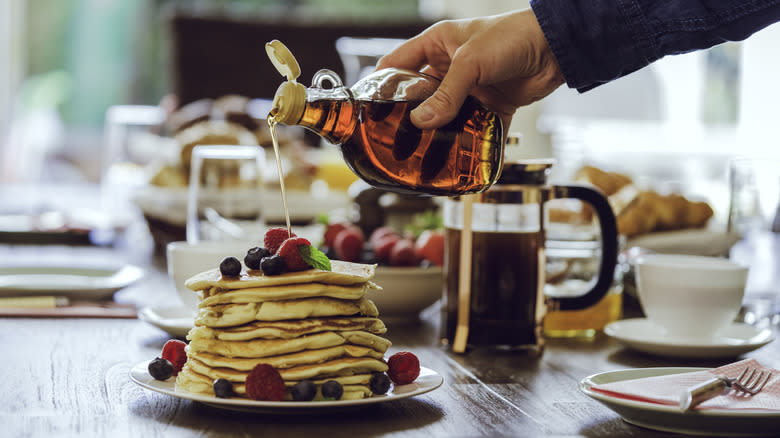
Maple syrup and pancakes is one of those classic combinations that never gets old. But there's no getting around it; maple syrup by definition is made of sugar. While better for you than the refined kind, maple syrup still contains high sugar levels. This counters any health benefits that you could get from the topping, making it a treat best enjoyed in moderation.
Many popular syrup brands contain unhealthy sweeteners and artificial ingredients. For example, Pearl Milling Company, formally known as Aunt Jemima, makes several different variations of what most people would consider maple syrup. However, a quick examination of the ingredients reveals that none of them actually contain maple syrup. The Original Syrup, for instance, is primarily made of corn syrup, high fructose corn syrup, and water. One serving, equivalent to 2 tablespoons, has 15 grams of added sugars. That's no insignificant amount, considering that the FDA advises limiting added sugar intake to 50 grams or less (based on a 2,000-calorie diet). The syrup also contains artificial flavors and caramel color to achieve that dark golden hue. Even worse, you'll find preservatives such as sodium benzoate, which is linked to various health concerns. Instead, stick to products that contain pure maple syrup and are free from added sugars, preservatives, or any other unwanted ingredients.
4. Fruit-Flavored Syrup
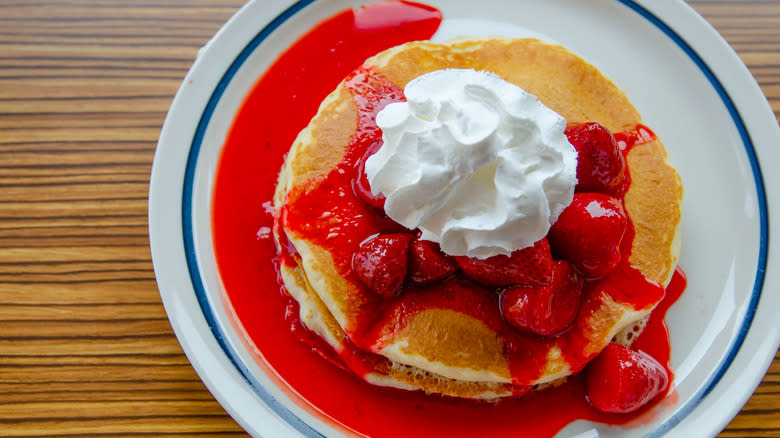
An alternative to maple syrup, fruit syrups typically sport berry flavors such as strawberry, blueberry, or raspberry. However, these toppings often have a lot of sugar. Take the Walmart Great Value Raspberry Fruit Syrup, complete with a stack of pancakes decorating the front of the bottle. A 2-tablespoon serving carries an astonishing 17 grams of added sugar, meaning that this topping alone will put you at 34% of your recommended daily allotment of added sugar. Now, factor in the sugar baked into the pancakes and other toppings. All in all, you might be close to (or over) the recommended daily limit.
A diet high in added sugar can carry several risks, including increased chances of developing diabetes, obesity, heart disease, and fatty liver disease. Foods high in sugar such as pancake toppings can also lead to cavities, tooth staining, and tooth decay. When choosing a fruit-flavored syrup, look for ones with less added sugar. It's just the nature of these products to have sugar, so it might be difficult to find one that relies solely on fruit for its sweetness.
5. Nutella
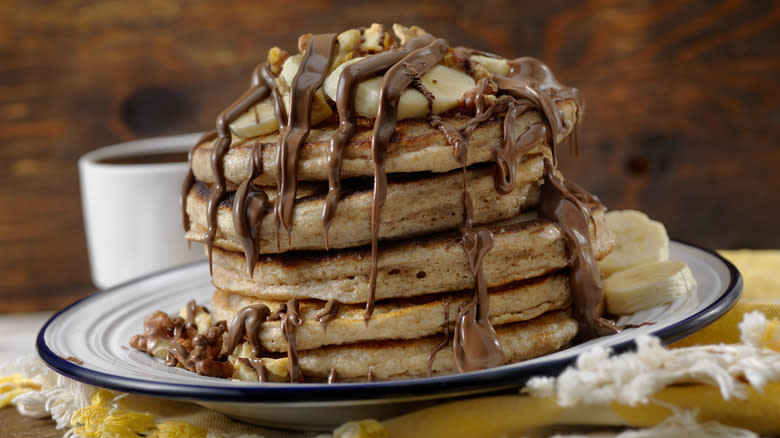
Nutella has earned its place as a pantry staple, making everything from toast and ice cream to baked goods even more special. Pancakes are no exception — there's nothing like a thick layer of Nutella with bananas or strawberries first thing in the morning. But while the chocolate hazelnut spread may seem innocuous, it's actually one of the highest-sugar pancake toppings out there.
Looking more closely at the nutrition label reveals why. A serving of Nutella contains 19 grams of added sugar — 38% of the daily value set by the FDA. One serving of Nutella is the size of 2 tablespoons, meaning that these numbers only increase the more you eat. To make matters worse, the American Heart Association recommends against consuming more than 25 grams of added sugar for women and 36 grams for men per day. The sugar in one serving of Nutella takes a huge chunk out of these numbers. Additionally, a serving delivers 20% of the day's recommended amount of saturated fat. While Nutella can be enjoyed in within limits, healthier options include nut butters or cocoa spreads that have less added sugar. One example is Justin's Chocolate Hazelnut Butter, which only contains 8 grams of added sugar in every serving.
6. Chocolate Syrup
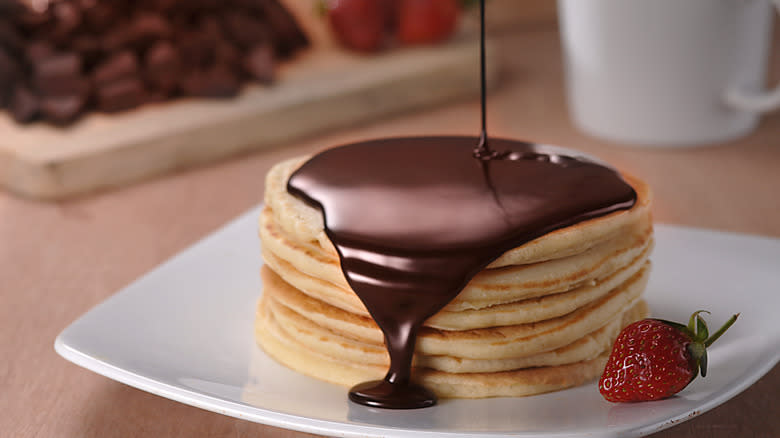
Perfect for sundaes, waffles, pancakes, hot cocoa, and other sweet things, chocolate syrup or sauce is also quite sugary on its own. For instance, a serving of Hershey's Chocolate Syrup has 10 grams of added sugar. However, a serving of only 1 tablespoon, which isn't very much in our opinion. Some chocolate fans may even use twice as much on a single stack of pancakes.
Ingredients-wise, Hershey's syrup has a lot more than chocolate and sugar. High fructose corn syrup is the first listed ingredient, followed by corn syrup. You'll also find preservatives, emulsifiers, and artificial flavors. Like with sugar, high fructose corn syrup is best consumed in moderation. Eating it in high quantities can contribute to obesity, high blood pressure, insulin resistance, and diabetes (via Cleveland Clinic). Cheaper to use than sugar, high fructose corn syrup is found in soft drinks, fruit juice, and sweets but also in many savory condiments, sauces, and processed foods. A healthier alternative is to make your own chocolate sauce from scratch. This way, you can control the ingredients and amount of sugar you use. You could also just stick with chocolate chips, which typically have less sugar than any bottled sauce or syrup.
7. Powdered Sugar
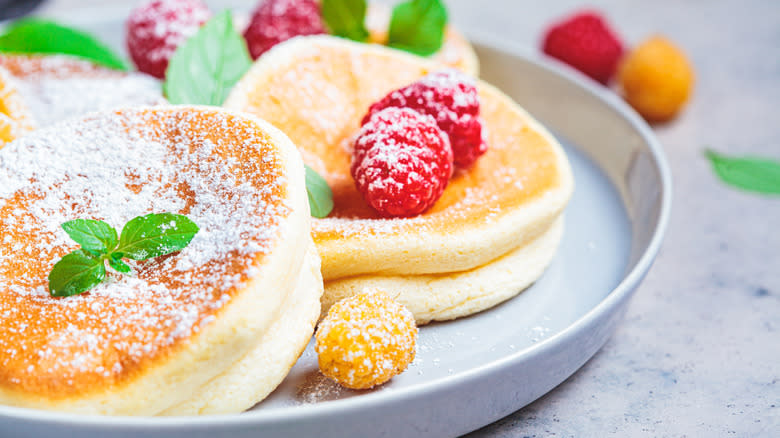
A common addition to pancakes and other sweets is powdered sugar, also known as confectioner's sugar. Pancakes are already sweet, so a dusting of even more sugar makes them extra delicious. Plus, powdered sugar is often joined by other sweet toppings, such as chocolate sauce or sweet syrup. While a little powdered sugar is fine, it's important to know how much is too much.
Looking at Great Value-brand powdered sugar, one serving is ¼ cup and includes 30 grams of sugar. While this value is high, most people wouldn't typically dump that much on top of their pancakes. Just for fun, eating a full serving of powdered sugar in one go would fulfill 60% of the recommended daily amount of added sugar. Though most might enjoy a sprinkle or light blanket of powdered sugar on their pancakes, remember that all this sugar adds up. Pair a powdered sugar with fresh fruit instead of maple syrup or whipped cream for a more balanced breakfast.
8. Fruit Spreads
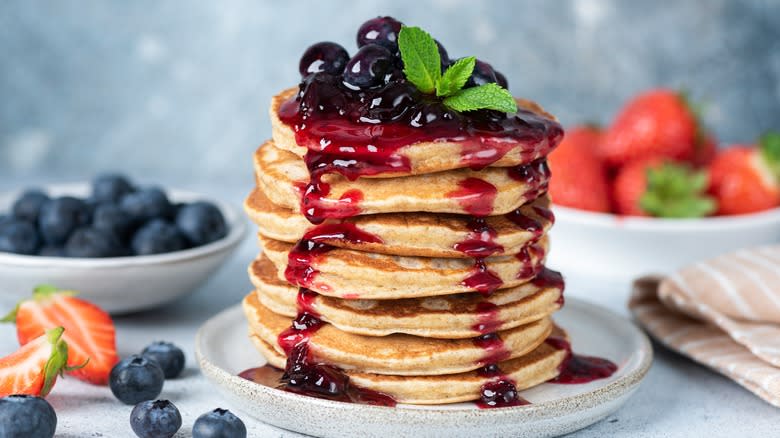
Jam, jelly, preserves, and marmalade all have one thing in common, and that's fruit. While fresh fruit is a good source of fiber, vitamins, minerals, and antioxidants, the fruit spreads you find in jars are full of added sugar. The sugar has a purpose here: to act as a preserving agent. Even so, fruit spreads should be enjoyed in small servings. And some offerings are better than others.
The popular brand Bonne Maman makes many types of fruit spreads, but the preserves tend to carry the most added sugar. A serving of strawberry preserves, the equivalent of a tablespoon, has 12 grams of added sugar. That's a lot for such a small serving. Depending on preferences, of course, 1 tablespoon of preserves is fit to top just one or maybe two pancakes. If you eat a full stack, that's a lot of sugar. On the bright side, Bonne Maman's strawberry preserves are made with fruit first and foremost, followed by cane sugar, lemon juice, and pectin, a natural fiber that helps the spread develop its gel-like texture. Other fruit spread brands use high fructose corn syrup in place of sugar, which some may seek to avoid in their diets.
9. Blackstrap Molasses
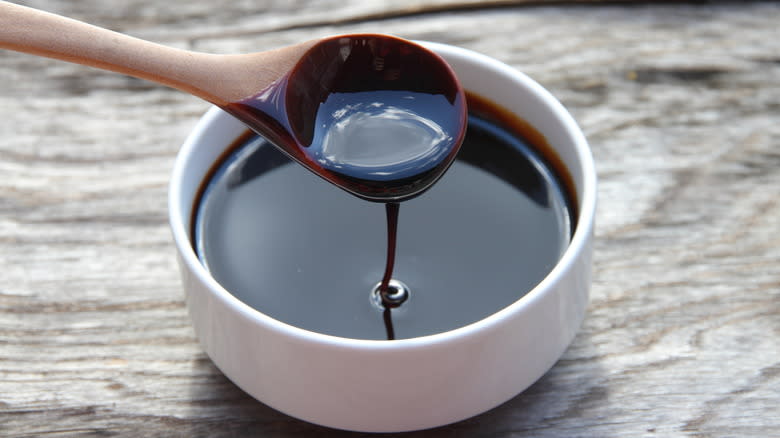
Blackstrap molasses is a more popular pancake topping in the U.K., where it's known by the name treacle. During the sugar making process, sugarcane juice is boiled, resulting in molasses as a byproduct. After several more boils, the molasses turns into the thicker blackstrap molasses. This sweetener has uses in baking but can also be enjoyed as a topping for yogurt, porridge, and pancakes. While many enjoy blackstrap molasses as you would maple syrup, others opt to whip it together with butter to make an even more decadent spread.
Blackstrap molasses can be a healthier alternative to regular sugar as it's rich in iron, potassium, calcium, and other nutrients. However, it still contains a good amount of sugar. For example, one serving of Golden Barrel brand blackstrap molasses, the size of a tablespoon, has 11 grams of sugar. This makes up 22% of your daily intake of added sugar, per the FDA's guidelines. Like with any sugar-based food, the sweetener should be consumed in small amounts.
10. Caramel
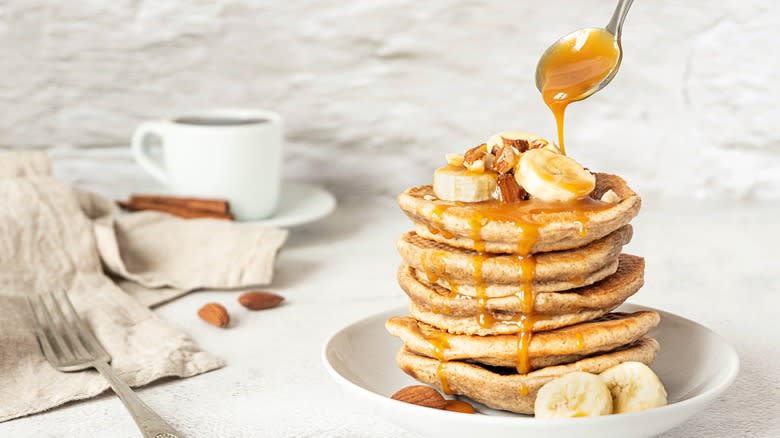
Caramel sauce or syrup is another super sweet sundae topping that's made its way to the breakfast table. A tasty alternative to maple or chocolate syrup, caramel often comes in squeeze bottles, though it's also simple to make at home. Of course, any caramel sauce you can buy or make will be full of sugar. Caramel is made from sugar, after all.
If you go the store-bought route, one option you'll likely see on shelves is Hershey's Caramel Syrup. The main ingredients are corn syrup, high fructose corn syrup, and sweetened condensed skim milk. Given all these sweet ingredients, it's no surprise that a single serving (1 tablespoon) contains 10 grams of added sugar. As a reminder, the FDA advises against consuming more than 50 grams of added sugar a day. While 10 grams may not seem significant, that's already ⅕ of the day's allotment, gone in 1 tablespoon. The syrup offers little nutritional value in return, and it also contains artificial flavors and coloring. While there's not really any way to make caramel healthy, it can help to create your own at home. This way, you can control the quality and quantity of every ingredient.
11. Ice Cream
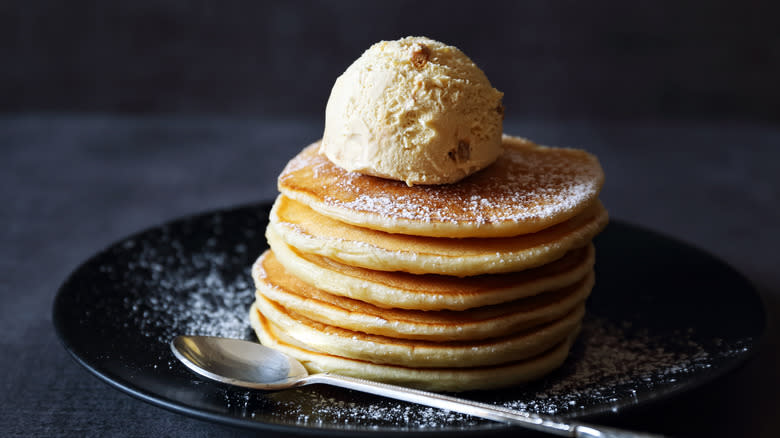
A truly indulgent way to upgrade your pancake game is to add a scoop or two of ice cream. But while delicious, this combination can overdo it on the sugar, especially if you also top your plate with syrup or whipped cream. Like pancakes, ice cream is a treat in and of itself. Even ice cream made with the highest quality ingredients can't be considered a healthy food by most standards.
If we look at vanilla ice cream from the popular brand Breyers, one serving is ⅔ cup and has 14 grams of added sugar. At 28% of the daily value, that's a lot of sugar. A serving of Breyers also has 30% of the day's recommended amount of saturated fat. Many store-bought ice creams are similarly high in sugar and fat. But don't worry — there's no need to cut ice cream out entirely. When you do reach for a pint, enjoy it in moderation. Also, avoid ice cream made with high fructose corn syrup, artificial flavors, and unhealthy preservatives.
12. Marshmallow Fluff
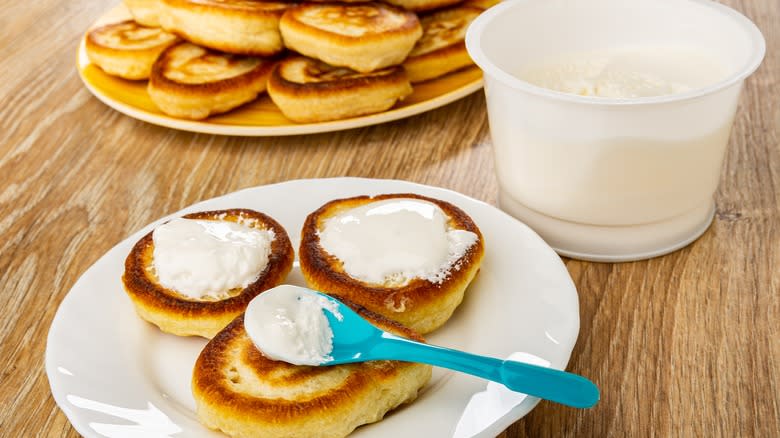
Marshmallow fluff or creme is a childhood staple for many, especially for those who grew up in New England. From the fluffernutter to hot cocoa, this creamy spread is often the star of the show. It also works well as a pancake topping, though it does add a considerable amount of sugar to an already sweet meal. A 2-tablespoon serving of Marshmallow Fluff contains 6 grams of added sugar. Its ingredients include corn syrup, dried egg whites, and artificial flavor, which some people may want to avoid. In comparison, a 2-tablespoon serving of Kraft Jet-Puffed Marshmallow Creme is made with similar ingredients and has 8 grams of added sugar.
While these marshmallow spreads have a low sugar content compared to the rest of the toppings on this list, they don't provide any significant nutritional value. On average, Americans eat too much added sugar in a day, according to Harvard Health. While everyone is different, it's important to read nutrition labels and limit or monitor your intake of added sugar.
13. Glaze
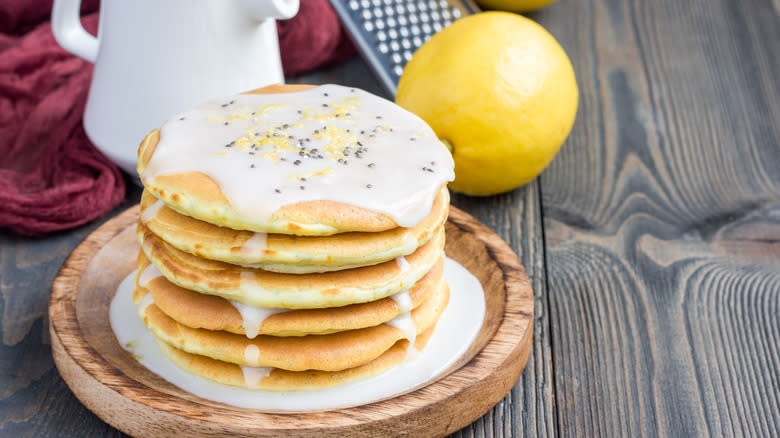
Glazes aren't just for cakes and breads — many people also enjoy them on their pancakes. There are many different types you could make, from a simple vanilla to orange or lemon-flavored glaze. While the main ingredient in frosting is cream cheese or butter, a glaze is typically made of powdered sugar and a liquid, often milk or juice. As we mentioned above, powdered sugar can significantly raise the sugar content of a plate of pancakes. Glaze is no different.
Every recipe varies, but what they all have in common is a lot of sugar. For example, Pillsbury's instructions for a basic glaze, which uses powdered sugar, milk, vanilla, and butter, has 19 grams of sugar per serving. Compared to the FDA's daily value of 50 grams of added sugar per day, this is significant. Other glazes pack even more sugar per spoonful. Needless to say, glazed pancakes are a sugary treat, but they can still be enjoyed on occasion.
14. Bacon
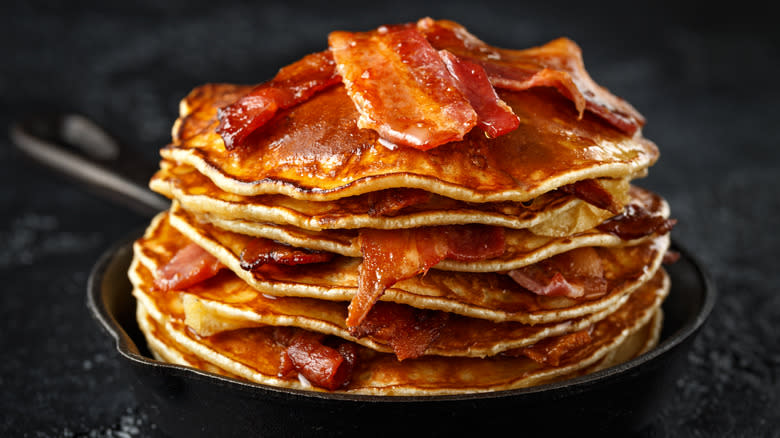
You've heard of chicken and waffles and pancakes with bacon on the side. So, it's really not that much of a stretch to imagine putting bacon on top of your pancakes. In fact, it's the preferred topping for many, along with butter and a drizzle of maple syrup. But as many bacon aficionados may already be aware of, processed meats come with a list of potential downsides.
First, bacon is high in fat, though this isn't something most people need to worry about if they follow the recommended serving size. Another common concern is that bacon tends to be very salty. For example, one serving of Oscar Mayer Naturally Hardwood Smoked Bacon is only two cooked pieces. A serving has 350 milligrams of sodium, which is a sizable chunk of the 2,300-milligram daily value for the nutrient. Factor in that many typically eat more than two strips of bacon, and you have a sodium overload on your hands. Eating excessive amounts of salt is linked to an increased risk of stomach cancer, and anyone sensitive to salt may also experience increased blood pressure. That's not all — common processing ingredients such as nitrates and nitrites can create carcinogenic compounds when cooked at high temperatures. All in all, it's best to limit how much bacon you eat.
How We Chose Our Unhealthy Pancake Toppings

When it comes down to it, pancakes are a blank canvas. You can put anything you imagine in or on top of them and call it a day. Given these unlimited options, we browsed food blogs and discussion boards to round up a selection of the most popular toppings. From among these, we evaluated each topping based on its nutritional value and sugar, fat, and sodium content. The toppings we selected are high in one or more of these nutrients. When applicable, we looked at popular brands offering these products and examined the types of ingredients they tend to use. We prioritized toppings commonly made with high fructose corn syrup, preservatives, artificial flavoring, and other unsavory ingredients.
Read the original article on Mashed

 Yahoo Lifestyle
Yahoo Lifestyle 
